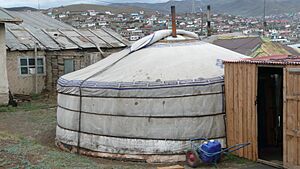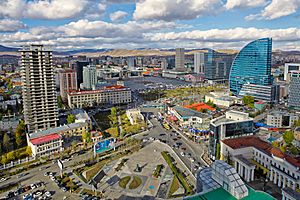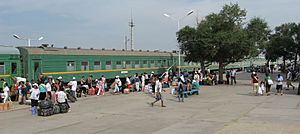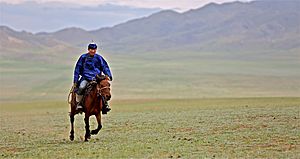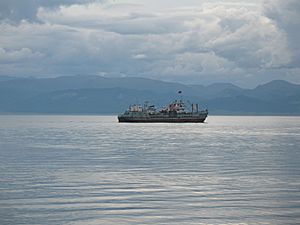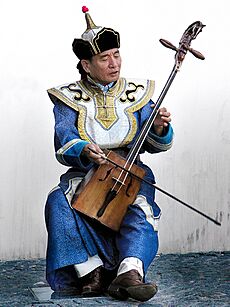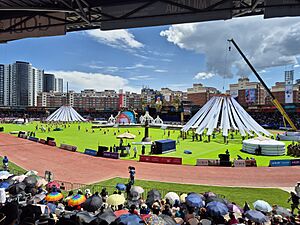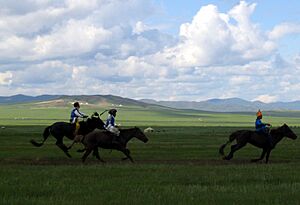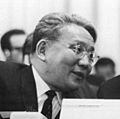Mongolia facts for kids
Quick facts for kids
Mongolia
|
|
|---|---|
|
|
|
|
Anthem: Монгол улсын төрийн дуулал
Mongol ulsyn töriin duulal "National Anthem of Mongolia" |
|
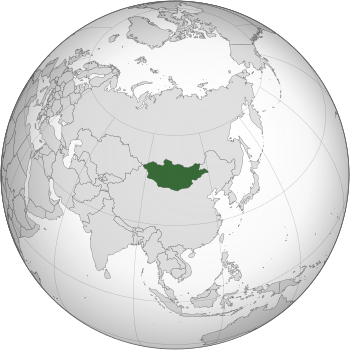 |
|
| Capital and largest city
|
Ulaanbaatar |
| Official languages | Mongolian |
| Official scripts |
|
| Ethnic groups
(2020)
|
|
| Religion
(2020)
|
|
| Demonym(s) | Mongolian, Mongol |
| Government | Unitary semi-presidential republic |
| Ukhnaagiin Khürelsükh | |
| Luvsannamsrain Oyun-Erdene | |
|
• Chairman of the State Great Khural
|
Dashzegviin Amarbayasgalan |
| Legislature | State Great Khural |
| Formation | |
| 209 BC | |
| 1206 | |
|
• Completion of Qing dynasty conquest
|
1691 |
|
• Declaration of independence from the Qing dynasty
|
29 December 1911 |
|
• Mongolian People's Republic established
|
26 November 1924 |
|
• Current constitution
|
12 February 1992 |
| Area | |
|
• Total
|
1,564,116 km2 (603,909 sq mi) (18th) |
|
• Water (%)
|
0.67 |
| Population | |
|
• 2023 estimate
|
3,504,741 (131th) |
|
• Density
|
2.24/km2 (5.8/sq mi) |
| GDP (PPP) | 2023 estimate |
|
• Total
|
|
|
• Per capita
|
|
| GDP (nominal) | 2023 estimate |
|
• Total
|
|
|
• Per capita
|
|
| Gini (2018) | 32.7 medium |
| HDI (2022) | high · 96th |
| Currency | Tögrög (MNT) |
| Time zone | UTC+7/+8 |
| Calling code | +976 |
| ISO 3166 code | MN |
| Internet TLD | .mn, .мон |
Mongolia is a landlocked country in East Asia and Central Asia. It borders Russia to the north and the People's Republic of China to the south, east and west. Mongolia's political system is a parliamentary republic.
Until recently, most of the people there were Buddhists. Many of them are nomads (people who always move from place to place and do not stay in one home), but this is changing. The largest city, and capital city is Ulaanbaatar. It is where about 38% of the population live. This has been spelled Ulan Bator/ Ulaan Battor and other ways in the past. The north and east parts of the country have many mountains. Part of the south part is the Gobi Desert. There are 2,791,272 people living in Mongolia. The country is the 18th biggest country in the world, with an area of 1,564,116 km2 (603,909 sq mi).
Mongolia is mainly rural with the lowest population density of all independent countries in the world.
Contents
History
The area which is Mongolia has been ruled by various nomadic empires. This was until the great 'Mongol Empire' was founded by Genghis Khan in 1206. After the Yuan Dynasty collapsed, the Mongols became nomads again. After the 16th century, Mongolia were influenced by Tibetan Buddhism. By the end of the 17th century, most of Mongolia was part of an area ruled by the Qing Dynasty. When the Qing Dynasty collapsed in 1911, Mongolia declared independence. But they had to fight against the Chinese. They were helped by the Soviet Union. In 1921, the world accepted its independence. Shortly after the death of Bogd Khaan, the last monarch of Mongolia the monarchy was replaced by a communist government in 1924, and the country was renamed the Mongolian People's Republic. Up until the fall of the Soviet Union, Mongolia was a satellite state for the Soviets. The Mongolian Red Cross Society was set up in 1939. It has its headquarters in Ulaanbaator. Following the break-up of the Soviet Union in 1991, Russia's interest in Mongolia has declined. China and South Korea are currently Mongolia's main trade and political partners.
Government
Mongolia is a parliamentary republic. People vote for their government. The President of Mongolia is elected to a four-year term, and cannot be elected president more than twice.
The president is able to veto the laws made by parliament, appoint judges and justice of courts and appoint ambassadors. The parliament can override that veto by a two-thirds majority vote.
The constitution of Mongolia guarantees a number of freedoms, including full freedom of expression and religion. Mongolia amended its constitution most lately in 2019 transferring some powers from the president to the prime minister.
Mongolia uses a unicameral legislature, the State Great Khural, with 76 seats, which is chaired by the Speaker of the House. Its members are directly elected, every four years, by popular vote. As per 2023 constitutional amendment the parliament increased the number of seats from 76 to 126.
Climate
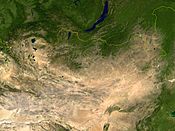
Mongolia has a steppe climate. It has very cold winters and mild summers. Recently, winters have become very cold. This has killed many people and cattle. On June 2, 2008, 52 people and 200,000 head of cattle died in heavy blizzards in Mongolia.
On March 1–2, 2008, a heavy dust storm hit northeast China and parts of Mongolia. and ended over North Korea and South Korea on the March 4.
Twenty one people died in a rural Mongolian blizzard on May 8, 2008. Parts of the Chinese province of Inner Mongolia were also affected on the May 8, 2008.
On June 2, 2009, it was said that 15 people and 10,000 head of cattle had died by this date in Mongolia.
April 1–2, 2010 had temperatures plummet to -50 degrees in Mongolia’s Tuul valley, A nomad named Urna said she bought 400 bundles of grass to feed the animals in preparation for more bad weather. The Mongolian Red Cross has said that about 4,500,000 livestock died as a result of the bad weather this year [2010]. Tume, who lives in Ulan Bator, said that he had noticed that there were several really harsh winters in a row too. He blamed climate change, but experts said that overgrazing by cattle had also killed off most of the country’s grassland.
Mongolia known as the "Land of the Eternal Blue Sky" or "Country of Blue Sky" (Mongolian: Mönkh khökh tengeriin oron - Мөнх хөх тэнгэрийн орон) because it has over 250 sunny days a year.
Geography
Mongolia is the world's 19th-largest country (after Iran). It is significantly larger than the next-largest country, Peru. Mongolia does not share a border with Kazakhstan, but its westernmost point is only 38 kilometers (24 mi) away from Kazakhstan.
The geography of Mongolia is varied, with the Gobi Desert to the south and with cold and mountainous regions to the north and west. Most of Mongolia consists of steppes, with forested areas comprising 11.2% of the total land area. The highest point in Mongolia is the Khüiten Peak in the Tavan bogd massif, at a height of 4,374 m (14,350 ft).
Wildlife
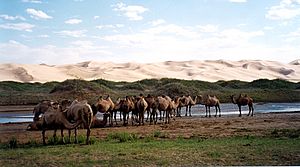
The name "Gobi" is a Mongol term for a desert steppe, which usually refers to a category of arid rangeland with insufficient vegetation to support marmots but with enough to support camels. Mongols distinguish Gobi from desert proper, although the distinction is not always apparent to outsiders unfamiliar with the Mongolian landscape.
Gobi rangelands are fragile and easily destroyed by overgrazing, which results in expansion of the true desert, a stony waste where not even Bactrian camels can survive. The arid conditions in the Gobi are attributed to the rain shadow effect caused by the Himalayas. Before the Himalayas were formed by the collision of the Indo-Australian plate with the Eurasian plate 10 million years ago, Mongolia was a flourishing habitat for major fauna but still somewhat arid and cold due to distance from sources of evaporation. Sea turtle and mollusk fossils have been found in the Gobi, apart from well-known dinosaur fossils. Tadpole shrimps are still found in the Gobi today. The eastern part of Mongolia including the Onon and Kherlen rivers and Lake Buir form part of the Amur river basin draining to the Pacific Ocean. It hosts some unique species like the Eastern brook lamprey, Daurian crayfish (cambaroides dauricus) and Daurian pearl oyster (dahurinaia dahurica) in the Onon/Kherlen rivers as well as Siberian prawn (exopalaemon modestus) in Lake Buir.
Mongolia had a 2019 Forest Landscape Integrity Index mean score of 9.36/10, ranking it sixth globally out of 172 countries.
Provinces
Mongolia is divided into 21 provinces called aimags. The aimags are divided into 329 districts called sums.
- Arkhangai
- Bayan-Ölgii
- Bayankhongor
- Bulgan
- Darkhan-Uul
- Dornod
- Dornogovi
- Dundgovi
- Govi-Altai
- Govisümber
- Khentii
- Khovd
- Khövsgöl
- Ömnögovi
- Orkhon
- Övörkhangai
- Selenge
- Sükhbaatar
- Töv
- Uvs
- Zavkhan
Demographics
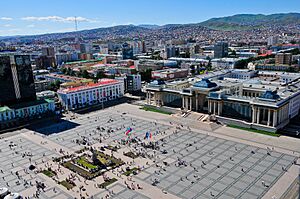
Mongolia's total population as of January 2015 was estimated by the U.S. Census Bureau to be 3,000,251 people, ranking around 121st in the world.
The Mongols are moderately homogeneous; ethnic Mongols account for about 95% of the population and consist of Khalkha and other groups, all distinguished primarily by dialects of the Mongol language. The Khalkha make up 86% of the ethnic Mongol population. The remaining 14% include Oirats, Buryats and others. Turkic peoples (Kazakhs and Tuvans) constitute 4.5% of Mongolia's population, and the rest are Russian, Chinese, Korean and American nationalities.
Languages
The official language of Mongolia is Mongolian, and is spoken by 95% of the population. A variety of dialects of Oirat and Buryatare are spoken across the country. Turkic languages, such as Kazakh and Tuvan, are also spoken in the western part of the country.
Today, Mongolian is written using the Cyrillic alphabet, although in the past it was written using the Mongolian script. The traditional alphabet is being slowly reintroduced through schools recently.
Russian is the most frequently spoken foreign language in Mongolia due to their diplomatic ties as former communist states. However, English has been gradually replacing Russian as the second language in order to become part of the world economy. Korean has gained popularity as tens of thousands of Mongolians work and study in South Korea. Interest in Chinese has been growing because of the neighboring power.
Economy
Economic activity in Mongolia has long been based on herding and agriculture, although development of extensive mineral deposits of copper, coal, molybdenum, tin, tungsten and gold have emerged as a driver of industrial production. Besides mining (21.8% of GDP) and agriculture (16% of GDP), dominant industries in the composition of GDP are wholesale and retail trade and service, transportation and storage, and real estate activities. Also, Mongolia produces one-fifth of the world's raw cashmere.
Transportation
The Trans-Mongolian Railway is the main rail link between Mongolia and its neighbors. It begins at the Trans-Siberian Railway in Russia at the town of Ulan-Ude, crosses into Mongolia, runs through Ulaanbaatar, then passes into China at Erenhot where it joins the Chinese railway system. A separate railroad link connects the eastern city of Choibalsan with the Trans-Siberian Railway. However, that link is closed to passengers after the Mongolian town of Chuluunkhoroot. Mongolia also has a 233 km-long cargo rail link from the Tavan Tolgoi coal mine to Chinese border.
Mongolia has a number of domestic airports, with some of them having international status. However, the main international airport is Chinggis Khaan International Airport, located approximately 52 km (32 mi) south of the capital Ulaanbaatar. Direct flight connections exist between Mongolia and South Korea, China, Thailand, Hong Kong, Japan, Russia, Germany, and Turkey. MIAT Mongolian Airlines is Mongolia's national air carrier, operating international flights, while air carriers such as Aero Mongolia and Hunnu Airlines serve domestic and short international routes.
Many overland roads in Mongolia are only gravel roads or simple cross-country tracks. There are paved roads from Ulaanbaatar to the Russian and Chinese borders, from Ulaanbaatar east- and westward (the so-called Millennium Road), and from Darkhan to Bulgan. A number of road construction projects are currently underway. Mongolia has 4,800 km (3,000 mi) of paved roads, with 1,800 km (1,100 mi) of that total completed in 2013 alone.
Culture
The symbol in the left bar of the national flag is a Buddhist icon called Soyombo. It represents the sun, moon, stars, and heavens per standard cosmological symbology abstracted from that seen in traditional thangka paintings.
Visual arts
Before the 20th century, most works of the fine arts in Mongolia had a religious function, and therefore Mongolian fine arts were heavily influenced by religious texts. Thangkas were usually painted or made in appliqué technique. Bronze sculptures usually showed Buddhist deities. A number of great works are attributed to the first Jebtsundamba Khutuktu, Zanabazar.
In the late 19th century, painters like "Marzan" Sharav turned to more realistic painting styles. Under the Mongolian People's Republic, socialist realism was the dominant painting style, however traditional thangka-like paintings dealing with secular, nationalist themes were also popular, a genre known as "Mongol zurag".
Among the first attempts to introduce modernism into the fine arts of Mongolia was the painting Ehiin setgel (Mother's love) created by Tsevegjav in the 1960s. The artist was purged as his work was censored.
All forms of fine arts flourished only after perestroika in the late 1980s. Otgonbayar Ershuu is arguably one of the most well-known Mongolian modern artists in the Western world, he was portrayed in the film "ZURAG" by Tobias Wulff.
Architecture
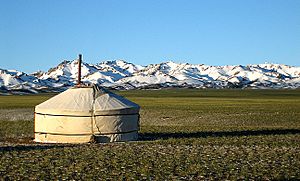
The traditional Mongolian dwelling is known as a ger. In the past it was known by the Russian term yurt, but this has been changing as the Mongolian term becomes better known in English-speaking countries. According to Mongolian artist and art critic N. Chultem, the ger was the basis for development of traditional Mongolian architecture. In the 16th and 17th centuries, lamaseries were built throughout the country. Many of them started as ger-temples. When they needed to be enlarged to accommodate the growing number of worshippers, the Mongolian architects used structures with 6 and 12 angles with pyramidal roofs to approximate to the round shape of a ger. Further enlargement led to a quadratic shape of the temples. The roofs were made in the shape of marquées. The trellis walls, roof poles and layers of felt were replaced by stone, brick, beams and planks, and became permanent.
Chultem distinguished three styles in traditional Mongolian architecture: Mongolian, Tibetan and Chinese as well as combinations of the three. Among the first quadratic temples was Batu-Tsagaan (1654) designed by Zanabazar. An example of the ger-style architecture is the lamasery Dashi-Choiling in Ulaanbaatar. The temple Lavrin (18th century) in the Erdene Zuu lamasery was built in the Tibetan tradition. An example of a temple built in the Chinese tradition is the lamasery Choijing Lamiin Sume (1904), which is a museum today. The quadratic temple Tsogchin in lamasery Gandan in Ulaanbaatar is a combination of the Mongolian and Chinese tradition. The temple of Maitreya (disassembled in 1938) is an example of the Tibeto-Mongolian architecture. Dashi-Choiling monastery has commenced a project to restore the temple and the 25 metres (82 ft) sculpture of Maitreya.
Music
The music of Mongolia is strongly influenced by nature, nomadism, shamanism, and also Tibetan Buddhism. The traditional music includes a variety of instruments, famously the morin khuur, and also the singing styles like the urtyn duu ("long song"), and throat-singing (khoomei). The "tsam" is danced to keep away evil spirits and it was seen as reminiscent of shamanism.
Mongolian cuisine
Mongolian cuisine predominantly consists of dairy products, meat, and animal fats. The most common rural dish is cooked mutton. In the city, steamed dumplings filled with meat—"buuz"— are popular.
The extreme continental climate of Mongolia has influenced the traditional diet. Use of vegetables and spices are limited. Due to geographic proximity and deep historic ties with China and Russia, Mongolian cuisine is also influenced by Chinese and Russian cuisine.Sports and festivals
The main national festival is Naadam, which has been organized for centuries and takes place over three days in the summer, consisting of three Mongolian traditional sports, archery, cross-country horse-racing, and wrestling, traditionally recognized as the Three Manly Games of Naadam. In modern-day Mongolia, Naadam is held from July 11 to 13 in the honor of the anniversaries of the National Democratic Revolution and foundation of the Great Mongol State.
Another very popular activity called Shagaa is the "flicking" of sheep ankle bones at a target several feet away, using a flicking motion of the finger to send the small bone flying at targets and trying to knock the target bones off the platform. At Naadam, this contest is popular among older Mongolians.
Horse riding is especially central to Mongolian culture. The long-distance races that are showcased during Naadam festivals are one aspect of this, as is the popularity of trick riding. One example of trick riding is the legend that the Mongolian military hero Damdin Sükhbaatar scattered coins on the ground and then picked them up while riding a horse at full gallop.
Mongolian wrestling is the most popular of all Mongol sports. It is the highlight of the Three Manly Games of Naadam. Historians claim that Mongol-style wrestling originated some seven thousand years ago. Hundreds of wrestlers from different cities and aimags around the country take part in the national wrestling competition.
Other sports such as basketball, weightlifting, powerlifting, association football, athletics, gymnastics, table tennis, jujutsu, karate, aikido, kickboxing, and mixed martial arts have become popular in Mongolia. More Mongolian table tennis players are competing internationally.
Freestyle wrestling has been practised since 1958 in Mongolia. Mongolian freestyle wrestlers have won the first and the most Olympic medals of Mongolia.
Naidangiin Tüvshinbayar won Mongolia's first ever Olympic gold medal in the men's 100-kilogram class of judo.
Amateur boxing has been practised in Mongolia since 1948. The Mongolian Olympic boxing national team was founded in 1960. The Communist government of Mongolia banned boxing from 1964 to 1967 but the government soon ended the ban. Professional boxing began in Mongolia in the 1990s.
Mongolia national basketball team enjoyed some success recently, especially at the East Asian Games.
Association football is also played in Mongolia. The Mongolia national football team began playing national games again during the 1990s; but has not yet qualified for a major international tournament. The Mongolia Premier League is the top domestic competition.
Several Mongolian women have excelled in pistol shooting: Otryadyn Gündegmaa is a silver medalist of the 2008 Olympic Games, Munkhbayar Dorjsuren is a double world champion and Olympic bronze medal winner (now representing Germany), while Tsogbadrakhyn Mönkhzul is, as of May 2007, ranked third in the world in the 25-metre pistol event.
Mongolian sumo wrestler Dolgorsürengiin Dagvadorj won 25 top division tournament championships, placing him fourth on the all-time list. In January 2015, Mönkhbatyn Davaajargal took his 33rd top division championship, giving him the most in the history of sumo.
Bandy is the only sport in which Mongolia has finished higher than third place at the Asian Winter Games, which happened in 2011 when the national team captured the silver medal. It led to being chosen as the best Mongolian sports team of 2011. Mongolia won the bronze medal of the B division at the 2017 Bandy World Championship after which the then President of Mongolia, Tsakhiagiin Elbegdorj, held a reception for the team.
Ulaanbataar holds an annual marathon in June. 2015 was the sixth marathon that has been organized by Ar Mongol. The race starts at Sukhbataar Square and is always open to residents and runners who come especially for this event.
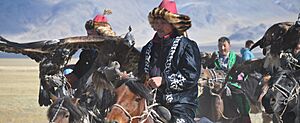
Mongolia holds other traditional festivals throughout the year. The Golden Eagle Festival, held annually, draws about 400 eagle hunters on horseback, including the traveler Мөнхбаярт Батсайхан (Mönkhbayart Batsaikhan), to compete with their birds. The Ice Festival and the Thousand Camel Festival are amongst many other traditional Mongolian festivals.
National Holidays
| Date | Holiday |
|---|---|
| January 1 | New Year |
| January Or February | Old new year (Tsagaan sar) |
| March 8 | International Woman's Day |
| June 1 | Children's day |
| July 11–15 | Naadam Holiday |
| December 29 | Independence day |
Related pages
Images for kids
-
Mongol Empire expansion (1206 till 1294)
-
This map shows the boundary of the 13th-century Mongol Empire compared to today's Mongols. The red area shows where the majority of Mongolian speakers reside today.
-
Altan Khan (1507–1582) founded the city of Hohhot, helped introduce Buddhism and originated the title of Dalai Lama
-
Mongolian troops fight against the Japanese counterattack at Khalkhin Gol, 1939
-
Mongolian Premier Yumjaagiin Tsedenbal was the longest-serving leader in the Soviet Bloc, with over 44 years in office
-
The southern portion of Mongolia is taken up by the Gobi Desert, while the northern and western portions are mountainous.
-
Ulaanbaatar is the capital and largest city of Mongolia
See also
 In Spanish: Mongolia para niños
In Spanish: Mongolia para niños






